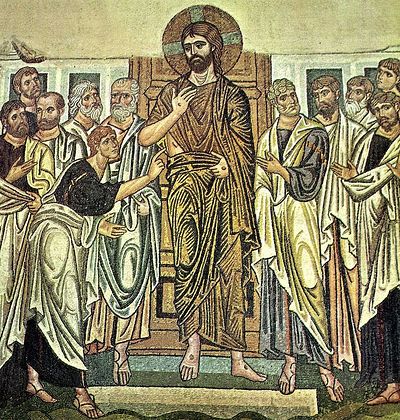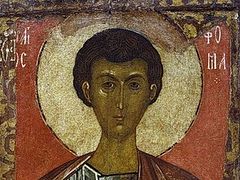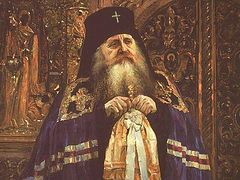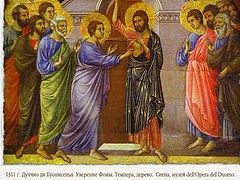Fr. Seraphim Holland, rector of the St. Nicholas Church in McKinney, Texas, answers ten questions on the first Sunday after Pascha—Thomas Sunday, also known as “Antipascha.”
Question
When is the Sunday of St. Thomas? Why? On the Sunday of St. Thomas, two hymns normally sung in Sunday matins are not sung. What are these hymns? Why are they not sung?
Answer
St Thomas Sunday is the Second Sunday of Pascha, or, said another way, the first Sunday after the Sunday of Pascha.
The Gospel text for the day gives a clue as to why the celebration is at this time: Then the same day at evening, being the first day of the week, when the doors were shut where the disciples were assembled for fear of the Jews, came Jesus and stood in the midst, and saith unto them, Peace be unto you (Jn. 20:19).
But Thomas, one of the twelve, called Didymus, was not with them when Jesus came. The other disciples therefore said unto him, We have seen the Lord. But he said unto them, Except I shall see in his hands the print of the nails, and put my finger into the print of the nails, and thrust my hand into his side, I will not believe (Jn. 20:24-26).
And after eight days again his disciples were within, and Thomas with them: then came Jesus, the doors being shut, and stood in the midst, and said, Peace be unto you... (Jn. 20:27).
On the Sunday of St. Thomas, the Resurrectional Evlogitaria sung before the Hymns of ascent which precede the Gospel, and immediately after either the Polyeleos or 118th psalm in normal times) are not sung, and neither is the “Magnificat” (“My soul magnifies the Lord...,” which is usually sung between the eighth and ninth ode of the matins canon). These hymns are omitted because the feast of St. Thomas Sunday is a “Feast of the Lord,” and it supersedes EVERYTHING from the normal Resurrectional service, just as Nativity, or another feast of the Lord would.
Question
A Hymn normally sung once in Sunday matins is sung three times, in the matins for St. Thomas Sunday, and until when? What is the hymn?
Answer
“Having beheld the resurrection” (certainly very familiar to everyone who has sung the Paschal Hours in lieu of morning prayers during Bright week, since it is also sung three times then), is normally sung once in Sunday matins, just after the Gospel is read. During the Paschal season, until and including the Sunday preceding Ascension Thursday, it is sung three times.
Question
How many days after the resurrection were required for Thomas to believe? Why did he not originally believe?
Answer
According to the Gospel of St. John, Jesus appeared unto the Apostles the first time on the evening of Pascha, with Thomas being absent, then the second time eight days later, with him being present. He originally did not believe because of the incredible reality of the Resurrection. He needed to see the evidence.
Question
How does the Holy Spirit, through the services characterize Thomas’ unbelief?
The church characterizes St. Thomas’ unbelief as “good”, because it led to a greater manifestation of the reality of Christ's resurrection in the flesh:
“As the disciples were in doubt, / the Savior came on the eighth day / to where they were gathered and granted them peace, / and cried unto Thomas: / Come, O Apostle, and feel the palms in which they fastened the nails. / O good unbelief of Thomas, / which hath led the hearts of the faithful to knowledge! / Hence, he cried out with fear: // O my Lord and my God, glory be to Thee” (Sticheron from Lord I have cried, vespers for St. Thomas Sunday).
Question
What strident words did the Holy Apostle Thomas say, which were quite similar to the Holy Apostle Peter’s just before the Passion Week of our Savior? Were these words shown to be sincere?
Answer
Just before Jesus went to Bethany to raise Lazarus, which preceded His passion week by only a little, St. John recounts in his Gospel:
Then said Thomas, which is called Didymus, unto his fellow disciples, Let us also go, that we may die with him (Jn. 11:16).
This sentiment was also expressed by the Holy Apostle Peter during the passion week:
Simon Peter said unto him, Lord, whither goest thou? Jesus answered him, Whither I go, thou canst not follow me now; but thou shalt follow me afterwards. Peter said unto him, Lord, why cannot I follow thee now? I will lay down my life for thy sake. Jesus answered him, Wilt thou lay down thy life for my sake? Verily, verily, I say unto thee, The cock shall not crow, till thou hast denied me thrice (Jn. 13:36-38).
St. John Chrysostom also states quite clearly the magnificent transformation of Thomas, and his great courage:
“Now they all feared the attacks of the Jews, but Thomas above the rest; wherefore also he said: Let us go, that we also may die with Him. Some say that he desired himself to die; but it is not so; the expression is rather one of cowardice. Yet he was not rebuked, for Christ as yet supported his weakness, but afterwards he became stronger than all, and invincible. For the wonderful thing is this; that we see one who was so weak before the Crucifixion, become after the Crucifixion, and after having believed in the Resurrection, more zealous than any. So great was the power of Christ. The very man who dared not go in company with Christ to Bethany, the same while not seeing Christ ran well nigh through the inhabited world, and dwelt in the midst of nations that were full of murder, and desirous to kill him” (St. John Chrysostom, sermon on St. John’s Gospel, verse 21:12).
Question
And after eight days again his disciples were within, and Thomas with them: then came Jesus, the doors being shut, and stood in the midst ... Then saith he to Thomas ... and be not faithless, but believing. And Thomas answered and said unto him, My Lord and my God (Jn. 20:26-27 (parts), 20:28).
What is the theological meaning of St. Thomas’s expression of worship?
Answer
An Old Believer Sermon, based mostly on the writings of St. John Chrysostom and Blessed Archbishop Theofylact of Bulgaria, among others, explains that the expression “My Lord and my God” indicates the dual nature of Christ. As a man, He is called Lord, as an earthly king might be, and also is God.
The Aposticha for the Vespers service echoes this idea:
“O strange wonder, / unbelief hath given birth unto steadfast faith! / For Thomas said: / Unless I see, I shall not believe. / And when he touched the side of Christ, / he spake with divine authority / concerning the Incarnate One Who is the very Son of God, / and recognized Him as the One Who suffered in the flesh. / He proclaimed the Risen God, and cried with a radiant voice: // O my Lord and my God, glory be to Thee.”
When Thomas proclaimed “My Lord and My God”, he was saying something wholly unique, never said before. This was the first time Jesus was explicitly called God by one of His disciples.
Question
How many times had the apostles as a group seen the risen Lord before St. Thomas saw Him and believed?
Answer
Jesus appeared to all the apostles save Thomas on the eve of the day of the Resurrection—Sunday evening. He did not appear again unto them until eight days later, when Thomas was with them.
Then the same day at evening, being the first day of the week, when the doors were shut where the disciples were assembled for fear of the Jews, came Jesus and stood in the midst ... But Thomas, one of the twelve, called Didymus, was not with them when Jesus came. And after eight days again his disciples were within, and Thomas with them: then came Jesus, the doors being shut, and stood in the midst... (Jn. 20:19a, 24,26a).
Question
What important priestly charism was given by Christ when He came to the upper room the first time He saw the apostles?
Answer
Jesus gave the apostles, and whom they would appoint, and their successors, down through the ages, the authority to bind and loose sins. A priest (or bishop, of course), usually exercises this authority and responsibility in the sacrament of confession.
Then the same day at evening, being the first day of the week, when the doors were shut where the disciples were assembled for fear of the Jews, came Jesus and stood in the midst, and saith unto them, Peace be unto you. ... Then said Jesus to them again, Peace be unto you: as my Father hath sent me, even so send I you. And when he had said this, he breathed on them, and saith unto them, Receive ye the Holy Ghost: Whosoever sins ye remit, they are remitted unto them; and whose soever sins ye retain, they are retained (Jn. 20:19, 21-23).
Question
What far away land did St. Thomas spread the Gospel to, where he met his end as a martyr?
Answer
The Holy Apostle Thomas spread the gospel to India, where he courageously met his end, being run through with five lances.
Question
What is unique about how the church reads the story of the doubting of Thomas?
Answer
On the day of Pascha, a portion of the story of the doubting of Thomas is read during Vespers. This Gospel is usually read in many languages, often in three short sections. The next week, on St. Thomas Sunday, the entire selection read during vespers is read again, and the story is finished, during the Divine Liturgy. This is the only time when a part of a Gospel is read one week, then the reading is completed the next week. It is also not common to read a Gospel selection in daily vespers.





